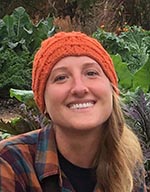Garden Talk
Horticultural Highlight: Clary Sage

In this series, the staff of Duke Gardens highlights plants you’ll find within our 55-acre living collection. This week Doris Duke Center Gardens horticulturist Lindsey Luks features one of her favorite useful plants.
Botanical name: Salvia sclarea
Common name: Clary sage
Family name: Lamiaceae (Mint Family)
Plant type: Biennial, short-lived perennial
Location in Duke Gardens: Mary Duke Biddle Rose Circle, Doris Duke Center Gardens, Terrace Gardens
Site requirements: Average, well drained soils, full sun. Keep out of standing water. Drought tolerant.
Native range: Europe to central Asia
USDA Hardiness Zones: 5-9

Clary sage is widely grown as a crop in the northeastern part of North Carolina. If you visit in early summer, you’ll be delighted to see thousands of acres, field after field, of these car-stopping flowers. It grows particularly well in this area due to the average, sandy, well-draining soil, but it can tolerate a wide range of soils so long as they don’t remain soggy in the winter.
Clary sage also does well in our compost-rich soil in the Charlotte Brody Discovery Garden, where it thrives and treats us all to a floriferous display of lilac purple to pink to white blooms every year. Clary sage also does well in our compost-rich soil in the Charlotte Brody Discovery Garden, where it thrives and treats us all to a floriferous display of lilac purple to pink to white blooms every year. Clary sage is a biennial, meaning it takes two years to complete its life cycle. It grows from seed the first year, producing large, green, broadly ovate, pubescent basal leaves, followed by a great increase in growth and 2- to 4-foot tall flower spikes the following year. Upon flowering, the mother plant produces seed and often dies. Upon flowering, the mother plant produces seed and often dies.
One may promote this plant to perennialize if the flower spikes are immediately cut off after blooming. We like to keep the old seed heads on the plants as birds, particularly the yellow finch, love to feast on them and we get new seedlings the following year.
The uses of clary sage are endless. The genus name Salvia comes from the Latin word salveo, meaning to save or heal, and harks back to the historical medicinal uses for this plant. Today its main use is centered on the extracted substance called sclareol which is then further refined into sclareolide. This substance is what takes your fabric softener or perfume’s scent from lasting a just few minutes to being able to last all day long, or even days on end.
Sclareolide is scentless, however, the clary sage plant itself is not one you would want to include in a bouquet in your home. The odor, which has been likened to dirty socks or a room where a kitty has missed the litter box, is particularly strong once the flowers have begun to fade but is not bothersome unless the plant is disturbed or is grown en masse, as are the thousands of acres of sage in northeastern North Carolina.
We grow this North Carolina heritage plant in the Charlotte Brody Discovery Garden to exemplify one of the most important crops to this state. The few counties in northeastern North Carolina that grow clary sage on such a large scale represent the few across the country that do so. Clary sage is not only a very useful plant, but also incredibly beautiful and loved by wildlife, and it deserves a place in every perennial border.

A clary sage field in Chowan County just beginning to bloom.

Sage growing in the Charlotte Brody Discovery Garden.
Photos by Lindsey Luks.





